OPPO did the right thing by giving up ProXDR
Not long ago, OPPO announced at the Paris Film Festival that it was working with Kazakhstan and the Soviet Union to create a new generation of super light and shadow imaging systems, which will be launched on the OPPO Find X7 series.
Choose to announce this news at the world’s largest and most influential photography exhibition, which shows how much OPPO attaches importance to the new generation of ultra-light and shadow imaging systems. According to OPPO, the new generation of super light and shadow imaging system mainly consists of three parts:
- Super light and shadow full main camera system, from increasing the zoom magnification to creating multiple viewing angles Creative freedom;
- Ultra-light and shadow image engine, using more calculations to achieve less calculation traces;
- Ultra-light and shadow ProXDR display, a photo display technology that conforms to the screen viewing method.
Among them, "Super Light and Shadow Full Main Camera System" refers to the hardware of the imaging system, "Super Light and Shadow Image Engine" refers to the algorithm of the imaging system, and "Super Light and Shadow ProXDR display" is the display of the imaging system.
ProXDR display, also known as photon matrix display technology, has a core purpose of bringing higher dynamic contrast between light and dark and more accurately restoring the natural viewing of photos. To some extent, this is OPPO’s own HDR display technology.
But what is intriguing is that it was also at this massive event that OPPO announced its embrace of the Ultra HDR standard.

Picture/OPPO
Ultra HDR was just launched by Google this year A set of high dynamic range display standards for static images, supported for the first time on Android 14. As a core Android OEM, OPPO's support is both sensible and reasonable on the surface.
The problem is that before Ultra HDR, OPPO had just launched the ProXDR display on the Find X6 series released at the beginning of this year. Since this year, in addition to supporting it on folding screens, it has also been decentralized It comes to the Reno series and OnePlus’ mid-to-high-end product lines. The embrace of Ultra HDR will inevitably affect the actual value and status of ProXDR display, because once Ultra HDR becomes popular, ProXDR will be almost "useless."
So is OPPO planning to give up ProXDR? Let’s not comment on this issue for now. First of all, we still need to know what Ultra HDR is and why OPPO chose to embrace it.
Ultra HDR, the future of mobile photography?
In May of this year, Google held its annual I/O conference, where it naturally released the next-generation Android 14 system. Among them, Google also announced that Android 14 will support Ultra HDR after adding support for HDR video in the last major version.
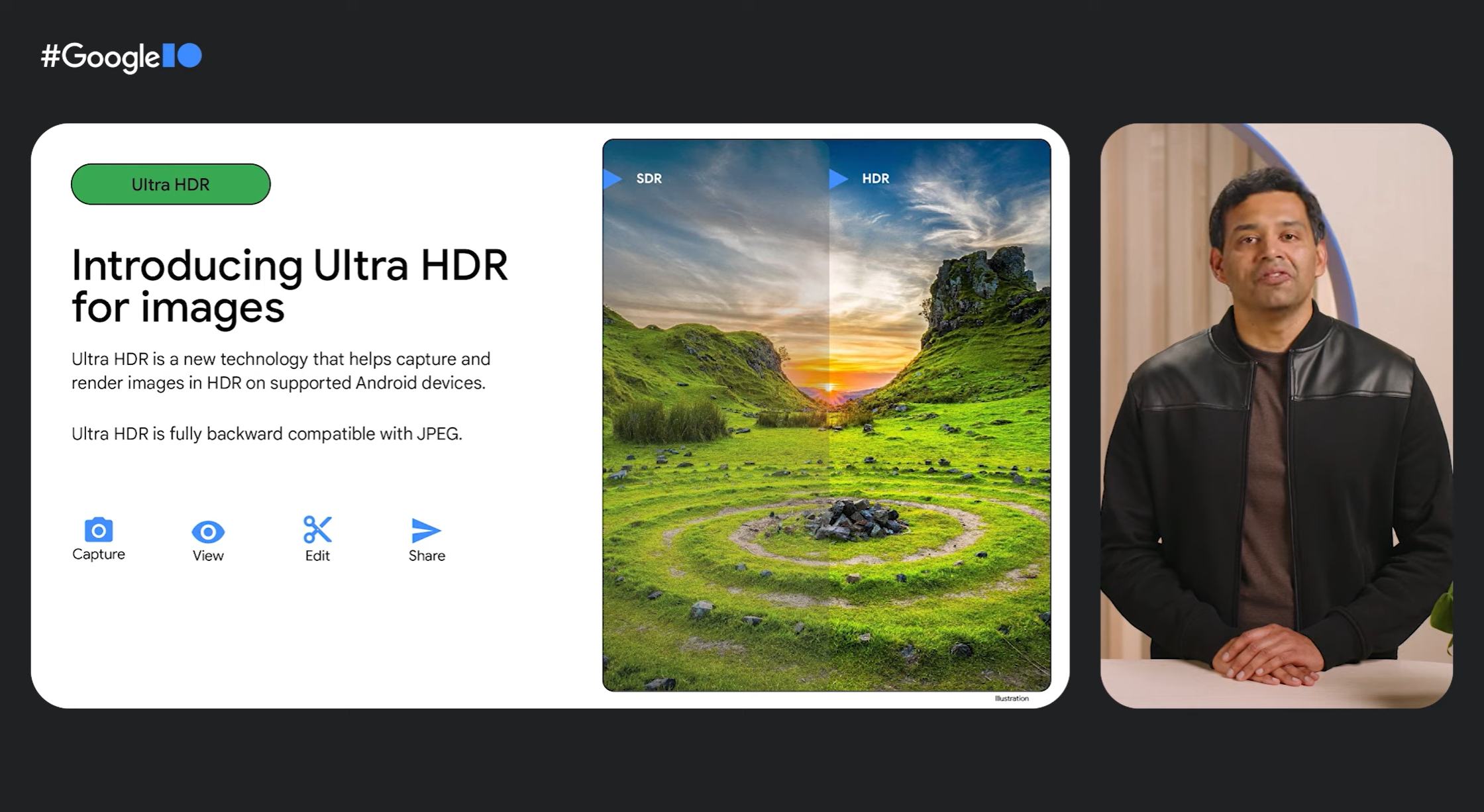
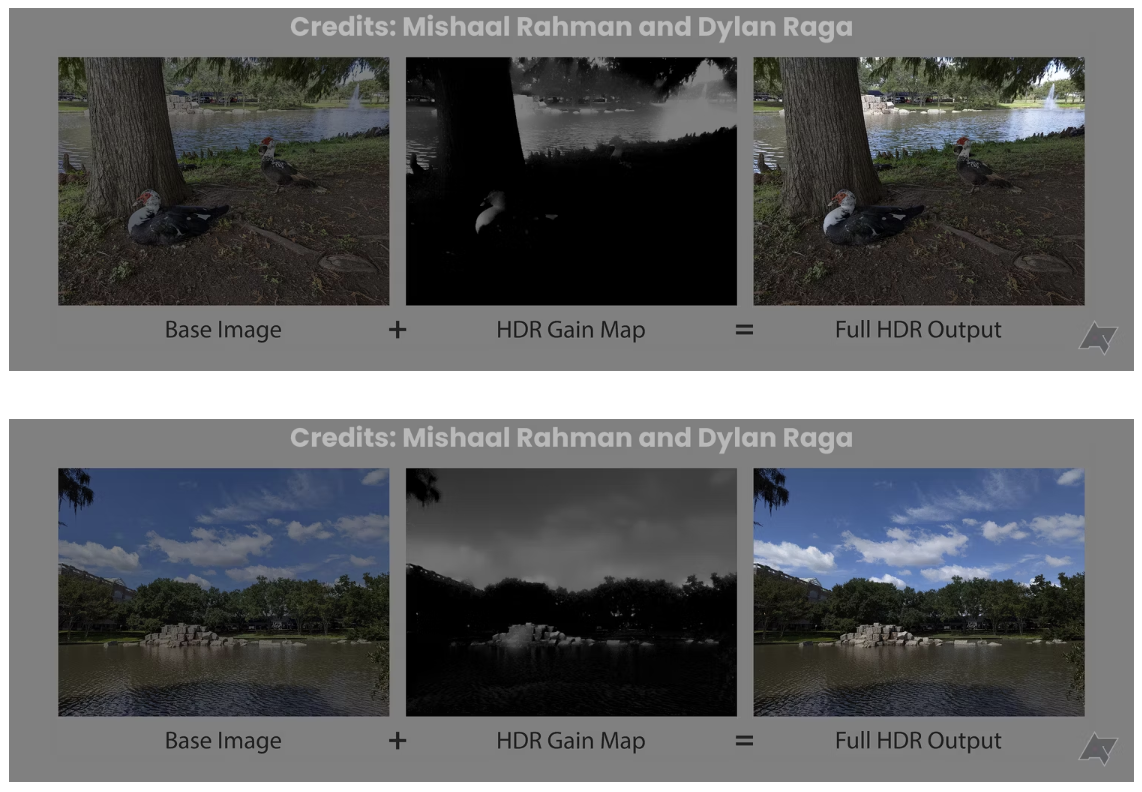 ##Picture/Android Police @Mishaal Rahman and Dylan Raga
##Picture/Android Police @Mishaal Rahman and Dylan Raga
Another On the one hand, the core difference between Ultra HDR and JPEG is that the HDR Gain Map is embedded in the metadata. To put it simply, Ultra HDR image files actually contain two layers of images, one is a JPEG image with standard dynamic range (SDR), and the other is a JPEG image with HDR Gain Map.
When rendering an Ultra HDR image on a device equipped with an SDR display, the SDR version without Gain Map will be displayed; when rendering the same image on a device that supports HDR display When editing an Ultra HDR image, a gain map is applied to the base image, resulting in an HDR image with clearer, more vivid colors and higher contrast.
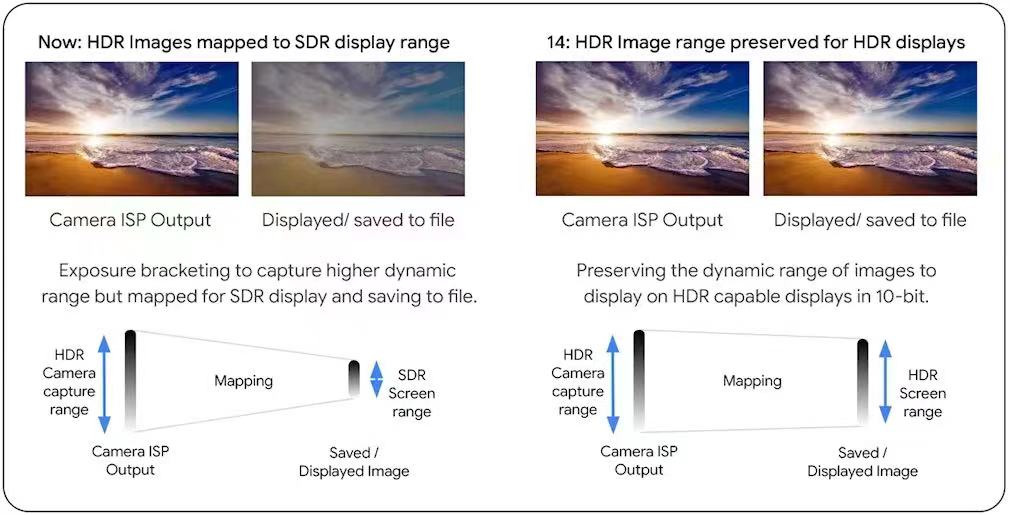 The second picture from the left shows the problem of HDR photos under SDR display screen in the past, picture/Google
The second picture from the left shows the problem of HDR photos under SDR display screen in the past, picture/Google
In short, Ultra HDR can completely not affect the display effect under the SDR display standard, and at the same time, under the HDR display standard, it can show the display effect that HDR should have.
Apple actually has a set of standards and technologies similar to Ultra HDR, called Extended Dynamic Range (EDR), which also uses the HDR gain map as an embedded map. The difference is that it is embedded HEIC/HEIF instead of JPEG images.
Of course, as a brand new image format, the biggest problem with Ultra HDR is "support". If software developers do not adapt to Ultra HDR, everything will still be empty talk. .
Fortunately, Google itself is one of the largest software developers in the world.

Picture/Google
When announcing that Android 14 would support Ultra HDR, Google announced that “Google Photos” would fully support it Ultra HDR format. You know, Google Photos had more than 1 billion users as early as 2019. The latest application report shows that the current number of Google Photos users has exceeded 2 billion.
Not only Google Photos, but also the Google Camera built into Pixel also supports the Ultra HDR format for the first time, as well as Chrome and all browsers based on Chromium used around the world. Including on MacOS platform.
In addition, Qualcomm has long announced support for Ultra HDR, and Adobe also announced in October that Lightroom will be the first to support the display and editing of Ultra HDR format. Of course, OPPO, as an OEM manufacturer, has also announced its embrace of the Ultra HDR ecosystem.
Mishaal Rahman, who focuses on Android research and reporting, believes that although it is still a very new image format, Ultra HDR will Be the future of mobile photography. The core is that Ultra HDR not only solves the big problem of SDR display, but also due to less tone mapping, the display effect of Ultra HDR is more balanced and natural, and will not be "too fake" as we often complain.
At the same time, Ultra HDR also makes OPPO ProXDR so necessary.
#ProXDR display, destined to become a thing of the past?
Strictly speaking, the correct name of ProXDR display is photon matrix display technology. OPPO claims that by collecting more than 12 million photon information points, it can accurately restore every pixel in the picture The light and shadow distribution achieves up to 8 times improvement in the dynamic range of light and dark.
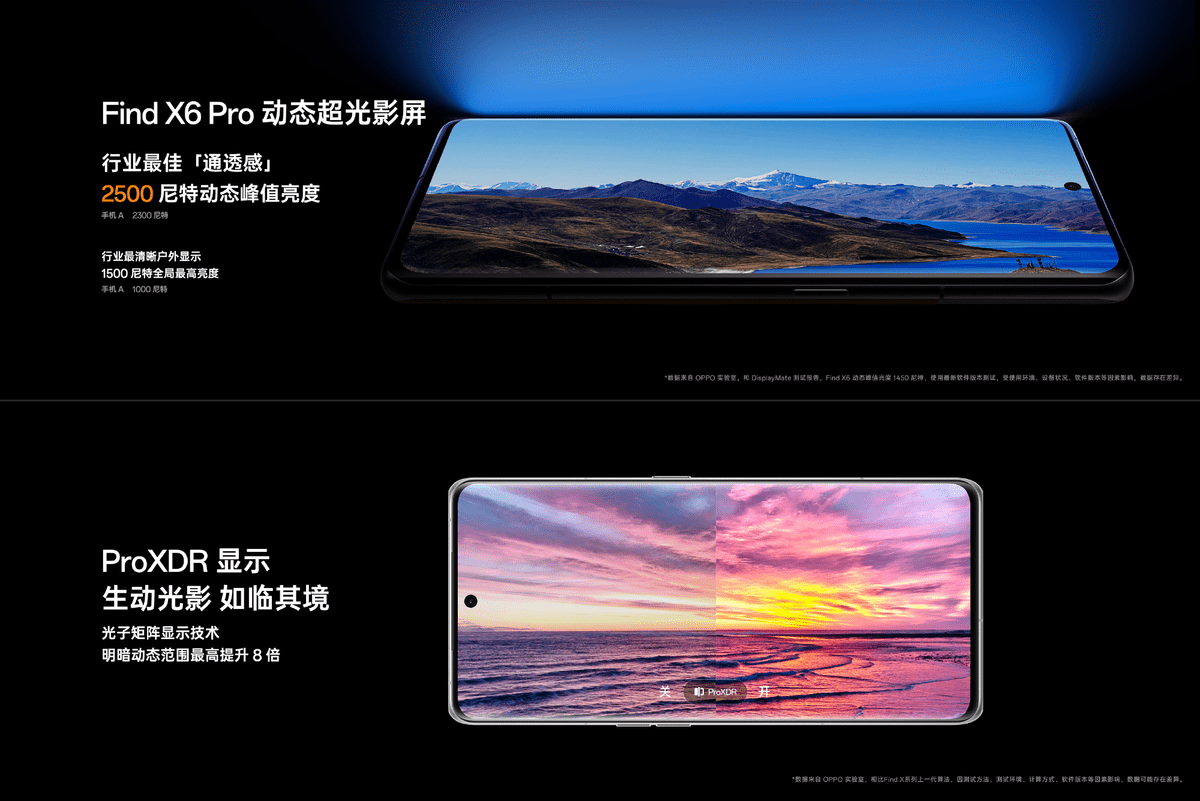
Official information, picture/OPPO
But from actual use Look, ProXDR is actually a bit misnamed, because in comparison, ProXDR actually only affects the highlights. Due to format support issues, ProXDR can only be displayed in the photo albums of a few OPPO models, so here we choose to use animations to show the comparison effect of ProXDR display:
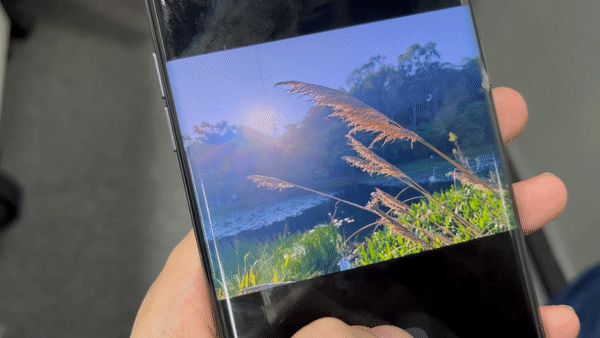
Turn on/off in OPPO Find There are visual differences between turning ProXDR on and off. Secondly, this contrast is not obvious enough, but it can already be shown that the ProXDR display actually only controls the bright parts, but has no effect on the dark parts.
In other words, let’s not discuss the gain effect on bright parts. Compared with the real HDR display, the ProXDR display can only be regarded as a semi-finished product, not to mention that OPPO has no impact on establishing the HDR ecosystem at all. power and appeal.
If nothing else, among the few OPPO models that support ProXDR display, even if you want to see the effect of ProXDR display, you can only use the system’s built-in In the photo album, other applications are not supported, including the "Notes" that comes with the system, and the effect of ProXDR display cannot be seen, let alone the support of other third-party applications.
You see, OPPO may not even pay much attention to it. Of course, you can also say that OPPO feels that supporting ProXDR display only in the photo album is enough.
In comparison, Ultra HDR obviously has better prospects and future. In addition to its better compatibility and display effect, Google, Qualcomm, Adobe, The Android ecosystem is also promoting the popularity of Ultra HDR. Even OPPO has announced its embrace of Ultra HDR in the name of "co-creating an ultra-light and shadow display ecosystem."
But OPPO probably also knows that once Ultra HDR becomes popular, the "half-disabled" ProXDR will be even more useless, and OPPO is unable to change all this. As Sun Yat-sen once said:
"The trend of the world is vast. Those who follow it will prosper, and those who go against it will perish."
The title picture shows OnePlus Ace 2 Pro, which also supports ProXDR display
The above is the detailed content of OPPO did the right thing by giving up ProXDR. For more information, please follow other related articles on the PHP Chinese website!

Hot AI Tools

Undresser.AI Undress
AI-powered app for creating realistic nude photos

AI Clothes Remover
Online AI tool for removing clothes from photos.

Undress AI Tool
Undress images for free

Clothoff.io
AI clothes remover

AI Hentai Generator
Generate AI Hentai for free.

Hot Article

Hot Tools

Notepad++7.3.1
Easy-to-use and free code editor

SublimeText3 Chinese version
Chinese version, very easy to use

Zend Studio 13.0.1
Powerful PHP integrated development environment

Dreamweaver CS6
Visual web development tools

SublimeText3 Mac version
God-level code editing software (SublimeText3)

Hot Topics
 1378
1378
 52
52
 Leica Sofort 2: Strong Leica taste, but the image quality is not satisfactory
Jan 03, 2024 pm 04:08 PM
Leica Sofort 2: Strong Leica taste, but the image quality is not satisfactory
Jan 03, 2024 pm 04:08 PM
Yes, I spent more than 3,000 yuan to buy a real Leica camera. This is not a joint brand between Xiaomi and Sharp. It is a real Leica camera. It can even be found in the official Leica APP. It is a brand new product launched by Leica just last month - Sofort2. (Picture source: Photographed by Lei Technology) Last month I wrote an article commenting on Leica’s new machine, which is simply cutting leeks. The price of more than 3,000 yuan to buy such a machine is extremely high in the polaroid market. A backward product must have too much money and no place to spend it, and is simply a "big mistake". But adhering to the concept that if I don’t go to hell, who else will, I still placed an order for the Leica Sofort2 on the night it went on sale and became a “real” Leica user. Appearance: An exquisite toy? Leica Sofo
 OPPO did the right thing by giving up ProXDR
Jan 06, 2024 pm 11:37 PM
OPPO did the right thing by giving up ProXDR
Jan 06, 2024 pm 11:37 PM
Not long ago, OPPO announced at the Paris Film Festival that it was working with Kazakhstan and the Soviet Union to create a new generation of super light and shadow imaging systems, which will be launched on the OPPO Find X7 series. Choosing to announce this news at the world's largest and most influential photography exhibition shows how much OPPO attaches importance to the new generation of ultra-light and shadow imaging systems. According to OPPO, the new generation of Super Light and Shadow imaging system mainly consists of three parts: - Super Light and Shadow full main camera system, from increasing the zoom magnification to creating multi-view creative freedom; - Super Light and Shadow image engine, using more calculations to achieve less Computational traces; - Ultra-light and shadow ProXDR display, a photo display technology that conforms to the screen viewing method. Among them, "super light and shadow full main camera system" refers to the hardware of the imaging system, and "super light and shadow image engine" refers to the image
 Can Meizu 21 Pro compete head-to-head with flagships from major manufacturers?
Jan 03, 2024 pm 06:10 PM
Can Meizu 21 Pro compete head-to-head with flagships from major manufacturers?
Jan 03, 2024 pm 06:10 PM
On the last day of November, Meizu took advantage of the new wave of Snapdragon 8Gen3 phones to bring its annual flagship new phone, Meizu 21. Not long ago, this site also conducted a review of this product. It is a mobile phone with obvious advantages and disadvantages. Moreover, Meizu 21 currently only has one model, unlike other brands that are divided into medium and large sizes. For those who want a super flagship, Meizu 21 seems a bit not “Pro” enough. (Photo source: Photographed by this site) However, recent news about Meizu 21Pro has appeared on the Internet, which is good news for Meizu friends who want more extreme configuration and experience. The screen of Meizu 21 is not strong enough? 2K screen is coming! The charging power of Meizu 21 is not high enough, 100W fast charging is coming! Could it be that Meizu 21 is just a “small test”?
 Razer Viper V3 Pro review: What's the trade-off between power and portability?
Jan 03, 2024 pm 04:17 PM
Razer Viper V3 Pro review: What's the trade-off between power and portability?
Jan 03, 2024 pm 04:17 PM
In the discussion about gaming mice some time ago, Xiao Lei mentioned that the first true “gaming mouse” was the Razer Boomslang released by Razer in 2003 – a USB game with a DPI of “up to” 2500 and a polling rate of 125Hz. mouse. But in fact, the statement is not accurate, because this 2100/25 polling rate 00DPI Boomslang is actually an upgraded version of this series. Its previous generation, Boomslang released in 1999, is the real first game. mouse. Compared with the second generation released 4 years later, the first generation Boomslang used a more primitive PS/2 interface, and the polling rate was only 10-200Hz; until 2005
 Redefining human-computer interaction, Honor MagicOS 8.0 is officially released!
Jan 11, 2024 pm 10:06 PM
Redefining human-computer interaction, Honor MagicOS 8.0 is officially released!
Jan 11, 2024 pm 10:06 PM
On January 10, 2024, Honor held its first offline conference of the year in Shanghai, where MagicOS 8.0 officially debuted. MagicOS8.0 is a new self-developed operating system created by Honor. It is the industry's first new generation of human-computer interaction - intent-recognized human-computer interaction. In addition, the new system also brings many new functions based on AI, such as "Any Door", "Conversation into Movies", "Multi-modal Schedule Management", etc. (Photographed by Lei Technology) Honor calls MagicOS8.0 a new generation of interactive mode system after command line interaction, graphical interaction and natural interaction. As for how awesome it is, let’s take a look below. A system that can learn, a system that understands you better. When it comes to "AI", in fact, Honor created its first smartphone as early as 2016.
 New affordable Meta Quest 3S VR headset appears on FCC, suggesting imminent launch
Sep 04, 2024 am 06:51 AM
New affordable Meta Quest 3S VR headset appears on FCC, suggesting imminent launch
Sep 04, 2024 am 06:51 AM
The Meta Connect 2024event is set for September 25 to 26, and in this event, the company is expected to unveil a new affordable virtual reality headset. Rumored to be the Meta Quest 3S, the VR headset has seemingly appeared on FCC listing. This sugge
 Huawei StarLight, wants to revolutionize Bluetooth?
Jan 11, 2024 pm 09:51 PM
Huawei StarLight, wants to revolutionize Bluetooth?
Jan 11, 2024 pm 09:51 PM
At a press conference some time ago, Huawei officially released a new generation of wireless connection technology - NearLink. Different from previous wireless technologies, NearLink is not developed based on the specifications of traditional wireless technologies such as Bluetooth, but Huawei's years of wireless experience. With the accumulation of technology, a new wireless connection specification is created. If you didn’t watch the press conference, it doesn’t matter. Let’s take a quick look at StarLight: it uses a set of standards to combine the advantages of traditional wireless technologies such as Bluetooth and WIFI. This technology is suitable for consumer electronics, smart homes, new energy vehicles, and industrial intelligence. Various scenes such as construction. Compared with Bluetooth technology, the power consumption is reduced by 60%, the transmission rate is increased by 6 times, it has lower latency, more stable connection and anti-interference ability, the coverage distance is increased by 2 times, and the number of connections is increased by 10 times. above
 Redmi Note 12 Turbo: Use tricks to create a flagship experience
Jan 15, 2024 pm 11:03 PM
Redmi Note 12 Turbo: Use tricks to create a flagship experience
Jan 15, 2024 pm 11:03 PM
In the TOP10 list of mobile phones with the largest shipments in 2022 announced by the market research organization Canalys, a mobile phone of the domestic brand Redmi appeared. Redmi Note 11 has also become the only domestic mobile phone on the list. When it comes to Redmi, every product is highly praised. It not only puts a lot of effort into materials and performance, but also provides a high-end flagship experience at a preferential price. What we are going to talk about today is Redmi’s latest Redmi Note12 Turbo, which uses magic to create a flagship experience. Appearance: In addition to releasing three standard colors of carbon fiber black, star sea blue, and ice feather white, Redmi Note12 Turbo also cooperated with "Harry Potter" to jointly create Note12 Turbo




